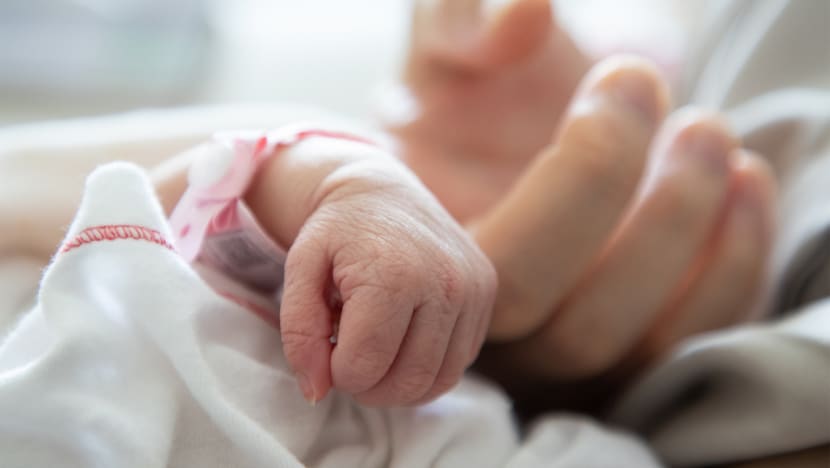KKH considering continuously monitoring newborn's vital signs after 11-day-old baby dies: Coroner
KK Women's and Children's Hospital told CNA after the coroner's hearing that it has taken steps to further strengthen its processes for monitoring babies who require admission to the special care nursery, including continuous monitoring of their vital signs.

File photo of a newborn baby. (Photo: iStock)
SINGAPORE: KK Women's and Children's Hospital (KKH) is reviewing its procedures to consider continuous documentation of a newborn’s vital signs, after a baby died of a type of injury that stems from a decrease in oxygen or blood flow to the brain.
State Coroner Adam Nakhoda encouraged the hospital to implement this practice, after finding that the lack of continuous documentation of the baby's vital signs "was not ideal". He made this note in a set of findings into the death of the baby made available over the weekend.
The 11-day-old baby died on Apr 12, 2021 of natural disease causes, and the case was referred to the coroner after the hospital alerted the police about the baby’s death.
He was born via emergency Caesarean, with his mother on general anaesthesia, after vaginal delivery by vacuum and forceps was unsuccessful and a slow foetal heart rate was detected for eight minutes.
His mother had been admitted to KKH at 39+1 weeks of pregnancy, and had gestational diabetes mellitus during her pregnancy as well as a prior history of Graves’ disease - an immune system disorder that affects the thyroid gland.
However, her thyroid function tests were normal during pregnancy, as well as her antenatal ultrasound scan.
The boy was born with three tight loops of umbilical cord around his neck. The cord was cleared and he was noted to have a "fair cry" when delivered.
POST-BIRTH EVENTS
KKH's neonatal resuscitation team immediately attended to the baby after birth and placed him on a resuscitator.
His initial heart rate was low, and he had borderline oxygen saturation, so he was given continuous positive airway pressure (CPAP) via nasal prongs until his condition improved.
The CPAP was discontinued at six minutes post-delivery, with the baby observed to be vigorous and have a "good cry". The rest of the examination findings were normal.
At about 5am, the doctors at the operating theatre were called away to attend to a Code Blue activation, referring to a medical emergency.
The baby remained in the operating theatre in the care of a senior staff nurse named only as SSN KJ in court documents. He was to be transferred to the special care nursery ward for observation.
SSN KJ weighed and measured the baby before placing him back on the resuscitator. According to her, measurements of the baby's oxygen saturation and heart rate via a probe attached to his palm were normal. However, she noted that his cry was "quite weak" and contacted the special care nursery ward for his transfer.
She then took him out of the resuscitator, placed him on a transport cot and took him to the viewing room for his father to look at him.
The baby's father took a video of his child, who was giving out weak cries, said the coroner. About four minutes into the video recording, the baby's father observed that the child was quiet, sleepy and responding slowly.
He asked SSN KJ if the baby was still sleeping. The nurse did not reply, instead uncovering the baby's swaddle and appearing to be monitoring him.
The baby appeared limp and was not showing any spontaneous limb movements. The nurse later said the baby was not breathing spontaneously and swaddled him again at 5 min 19 sec into the recording, before taking him back to the operating theatre.
In the operating theatre, the nurse put the baby back on the resuscitator and attached a probe to him. He did not appear to be breathing spontaneously, so the nurse administered intermittent positive pressure ventilation using a resuscitator, before activating a neonatal code blue emergency at 5.22am.
A team comprising an on-call consultant, an on-call senior resident and two on-call junior residents went to attend to the baby.
He was showing no response to stimulation at 5.25am, so he was intubated and given manual ventilation before being transferred to the neonatal intensive care unit (NICU). His fraction of inspired oxygen had decreased to 21 per cent.
He reached the NICU at 5.36am and was connected to a ventilator. At about 8.30am, he began developing clinical seizures including breath-holding, followed by rapid breathing and movement of his upper limbs.
He was treated for the seizures and referred to the neurology team for co-management, but later was found to have copious amounts of fresh blood in his mouth.
Between the second and fifth day of his life, the baby's condition remained largely unchanged, with no discernible change in the neurological findings.
A magnetic resonance imaging (MRI) of the child’s brain revealed, among other things, swelling and bleeding.
The baby remained on low ventilator settings but did not show any spontaneous movements or spontaneous respiratory effort, with his pupils remaining fixed and dilated.
The findings were communicated to the baby's parents, and they agreed after consideration on day six to actively withdraw care, with provision for sedation and pain medications.
He was pronounced dead on Apr 12, 2021.
An autopsy found the cause of death to be hypoxic ischaemic encephalopathy (HIE). This is a type of brain dysfunction or injury that occurs when the brain experiences a decrease in oxygen or blood flow.
The HIE was possibly related to Long QT Syndrome - a heart signalling disorder that can cause fast, chaotic heartbeats or arrhythmias - with an abnormally low foetal heart rate. Forensic pathologists said the cause of death was probably due to a natural disease process.
THE FATHER’S QUESTION
During the coroner's inquiry, the baby's father asked why the child was not put on a ventilator to assist his breathing after he was noted to have breathing difficulties.
A consultant at KKH who wrote the medical report for the case said the baby was born limp with a slow heart rate, and the medical team had to go through the standard resuscitation process.
Six minutes after birth, he was deemed to be breathing sufficiently well and CPAP was discontinued. According to KKH's protocol, he was to be transferred to the special care nursery as he had been subject to resuscitation.
The baby was hooked up to a probe that would have recorded his oxygen saturation and heart rate, but there was no electronic record of these readings as they were not captured by KKH's electronic medical records system.
The only vital sign recordings noted were the ones at the sixth and seventh minute after birth. When he was placed in the transport cot and brought to the viewing room, the probe was disconnected.
There was no objective evidence to establish the baby's condition prior to his transfer to the viewing room, said the coroner.
A further medical report by KKH stated that there was no documentation of continuous monitoring of the baby's vital signs considering his initial stable status.
It was emphasised to the neonatology teams that they should ensure that any newborn babies who require oxygen supplementation should be accompanied by medical personnel.
State Coroner Adam Nakhoda found no foul play in the baby's death and returned a finding of death by natural causes.
However, he noted that the baby's vital signs were not recorded from the seventh minute after birth, until he was taken back to the operating theatre.
"I found that the lack of continuous documentation of (the baby's) vital signs was not ideal. I am heartened by the fact that KKH is reviewing its procedures to consider continuous documentation of a newborn’s vital signs and I would encourage the hospital to implement this," he said.
However, he said the nurse's actions were otherwise appropriate.
The coroner said it is not known what exactly caused the baby to stop breathing when he was in the viewing room, but investigations later revealed he had a KNCQ1 missense variant and that mutations in the KNCQ1 gene have been known to cause arrhythmias or chaotic heartbeats.
He accepted the forensic pathologist's opinion that the HIE was not caused as a result of traumatic or unnatural circumstances, and found instead that his death was consistent as being a result of a natural disease process.
The coroner said losing a child is always a devastating event, perhaps more so when the child is a newborn, and extended his condolences to the baby's parents.
In response to CNA's queries, KKH said on Friday (Jan 27) that it has taken steps to further strengthen its processes for monitoring babies who require admission to the special care nursery, including continuous monitoring of their vital signs.
"The continuous monitoring enables our clinical staff who is always present to be immediately alerted in the event of any abnormalities, as triggered by the system," said Associate Professor Chan Yoke Hwee, chairman-designate of the medical board and chairman of the medicine division at KKH.
"We have also reinforced continual documentation of the baby’s vital signs, in line with the coroner’s findings.
"We are committed to continually reviewing our processes to enhance our standard of care."














